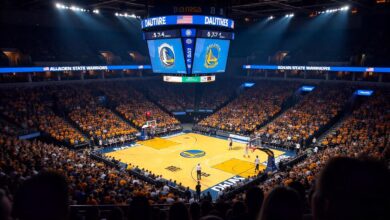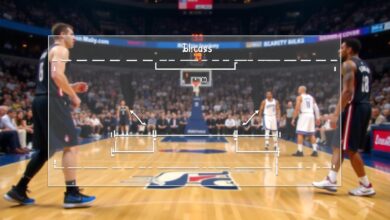Sunday Reflection: Lakers vs Utah Jazz — The Quiet Art of Team Chemistry and Efficient Ball Movement

In a league often dazzled by highlight reels, explosive dunks, and buzzer-beating three-pointers, last night’s Lakers vs Utah Jazz matchup offered something a little different — a subtle masterclass in basketball’s quieter virtues. The final score only tells part of the story. To truly appreciate the game, you need to look beyond the flashy moments and focus on the undercurrent of team chemistry, ball movement, and quiet efficiency that dictated the rhythm and outcome.
This game wasn’t about individual heroics or electric highlight plays. Instead, it was a showcase of how basketball, at its best, is a collective effort — a dance where each player knows their role, trusts their teammates, and moves in harmony. And the player stats reflect this beautifully.
Contents
The Pulse of Team Chemistry
Team chemistry is often an intangible quality — something you feel rather than measure. But when it’s working well, it translates into tangible outcomes like seamless passes, smart cuts, and timely defensive rotations. The Lakers and the Jazz demonstrated this throughout the game, each in their own way.
The Lakers, traditionally known for their star power, seemed more committed last night to sharing the load. LeBron James, while still pivotal, wasn’t the sole focal point of offense. Instead, he became more of a facilitator, reflected in his assist numbers that quietly stood out — he racked up 8 assists alongside 22 points, underscoring his role as a seasoned floor general.
Anthony Davis complemented this perfectly with a quieter stat line — 18 points and 10 rebounds, yes, but also 4 assists and an impressive +12 plus-minus rating. His involvement wasn’t just scoring; it was about setting screens, rolling at the right time, and creating passing lanes. These subtle contributions often get lost in highlight clips but are vital for team rhythm.
The Jazz, on their side, have long been celebrated for their unselfish style, and this game was no different. Mike Conley and Jordan Clarkson epitomized this with a combined 14 assists on the night, showing that their offense flows through multiple hands rather than a single superstar. Conley’s 16 points and 7 assists were a textbook example of a player who elevates his teammates rather than hogging the spotlight.
Ball Movement Over Flashy Play
If there was a hallmark of this game, it was ball movement. The Lakers finished with 27 team assists to the Jazz’s 25, numbers that tell us this was a game dominated by the pass rather than isolation plays. The Lakers’ assist-to-turnover ratio was a solid 1.8, indicating disciplined decision-making that allowed them to maintain offensive flow without careless mistakes.
Watching the replay, you’ll notice how many possessions ended with a well-timed kick-out or a sharp cut to the basket rather than a one-on-one isolation. The players moved the ball around patiently, probing defenses until a small crack appeared — then they exploited it with precision.
D’Angelo Russell, coming off the bench for the Lakers, embodied this ethos. Though he scored a modest 12 points, his 6 assists and 2 steals showcased his role as a dynamic playmaker who thrives on creating opportunities for others. His assist-to-turnover ratio was an impressive 3:1, a testament to his calm handling and vision.
For the Jazz, Royce O’Neale’s contribution was quietly impactful. His 10 points came on efficient shooting (5-for-7), but more importantly, he grabbed 7 rebounds and dished out 3 assists. O’Neale’s willingness to do the dirty work — setting screens, boxing out, and moving without the ball — helped keep the Jazz offense fluid and their defense sound.
Efficiency: The Understated Hero
The beauty of this Lakers vs Utah Jazz game lay in efficiency — not just in scoring but in every facet of the game. Neither team was chasing volume; both prioritized quality over quantity.
The Lakers shot a respectable 47% from the field and 37% from three-point range, but more tellingly, they only took 15 free throws compared to Utah’s 25 attempts. This signals a deliberate, patient offensive approach that favored crisp ball movement over aggressive drives to the basket. It also meant the Jazz were disciplined defensively, contesting shots without fouling excessively.
On the Jazz’s end, their overall shooting percentage was slightly lower at 44%, but they limited their turnovers to just 11, enabling more possessions and better rhythm. Their assist-to-turnover ratio of 2.27 was a standout figure, showing that they valued possession control and made the most of each trip down the court.
Efficiency also showed up on the glass. The Lakers outrebounded Utah 44-39, but it was the offensive rebounds that counted — 12 second-chance opportunities versus Utah’s 7. This gave the Lakers more chances to reset their offense and keep their pressure on.
Beyond the Box Score: The Intangibles
What the stats can’t fully capture are the moments of unselfishness and trust that quietly built momentum. For example, Austin Reaves, who didn’t top the scoring chart, had a significant influence by constantly moving without the ball, finding open spots, and hitting timely mid-range jumpers. His ability to read defenses and move accordingly created spacing that allowed Davis and James to operate more freely.
Similarly, Utah’s Gobert anchored the defense with his rim protection, altering shots and grabbing 5 blocks. Yet, his defensive presence also allowed perimeter defenders to pressure ball handlers more aggressively, contributing indirectly to Utah’s 11 forced turnovers.
The flow of the game, with its ebbs and swells, was a product of trust — each player knowing where teammates would be, anticipating cuts and passes without needing to look. This kind of chemistry doesn’t happen overnight; it’s built over practices, film sessions, and countless minutes on the court together.
What This Means Going Forward
In an era dominated by superstars and individual accolades, this Lakers vs Utah Jazz game is a reminder that basketball remains, at its core, a team sport. Success is often built on these quiet efficiencies and unselfish plays rather than highlight reels.
For the Lakers, embracing this style bodes well for their championship aspirations. When LeBron and Davis play in concert with a supporting cast that moves the ball and defends collectively, they become a far tougher team to beat.
For Utah, their identity as a cohesive, smart, and efficient squad remains intact. Their ability to share the ball and maintain control under pressure is a hallmark of a well-coached team that knows its strengths.
Both teams showcased that winning basketball is as much about patience and intelligence as it is about athleticism and flash. The beauty lies in those little details — the extra pass, the timely screen, the off-ball cut — that add up to a symphony of teamwork.
Final Thought
As fans, it’s easy to get caught up in the spectacle of highlight dunks and three-point barrages. But the Lakers vs Utah Jazz game reminds us of the deeper satisfaction found in watching a team operate as a well-oiled machine — where every player contributes quietly, efficiently, and selflessly.
On this calm Sunday morning, that kind of basketball offers not just a game, but a lesson in humility, teamwork, and the art of playing the right way.





